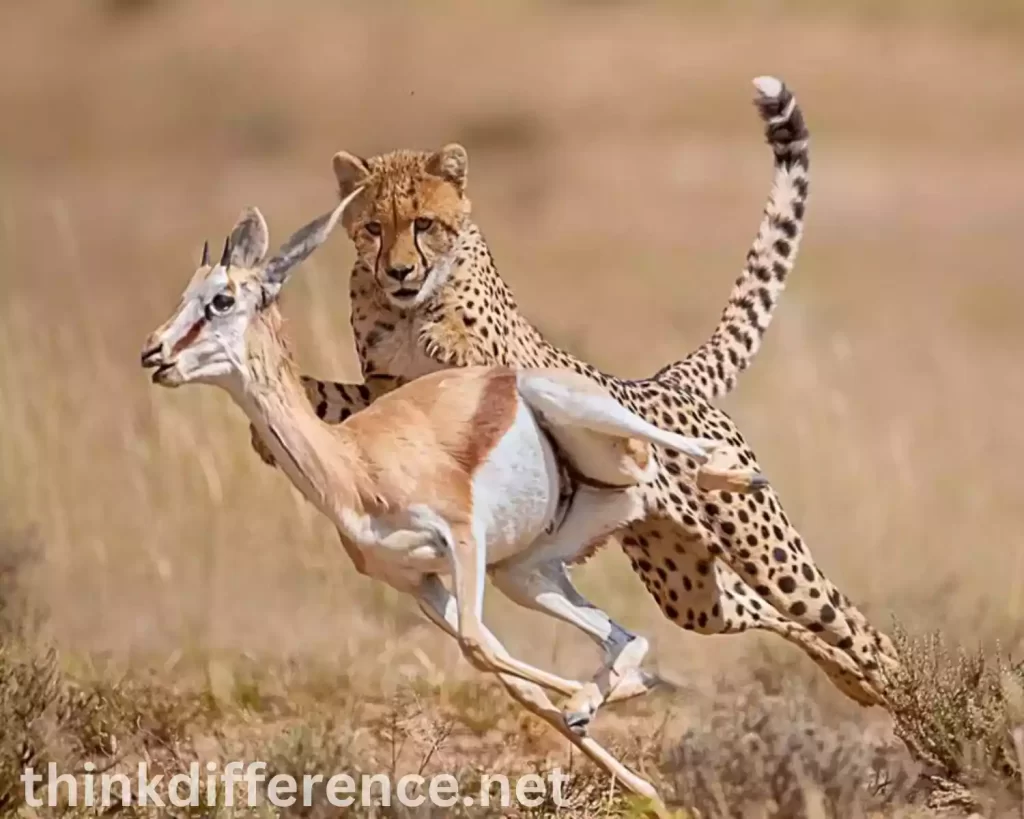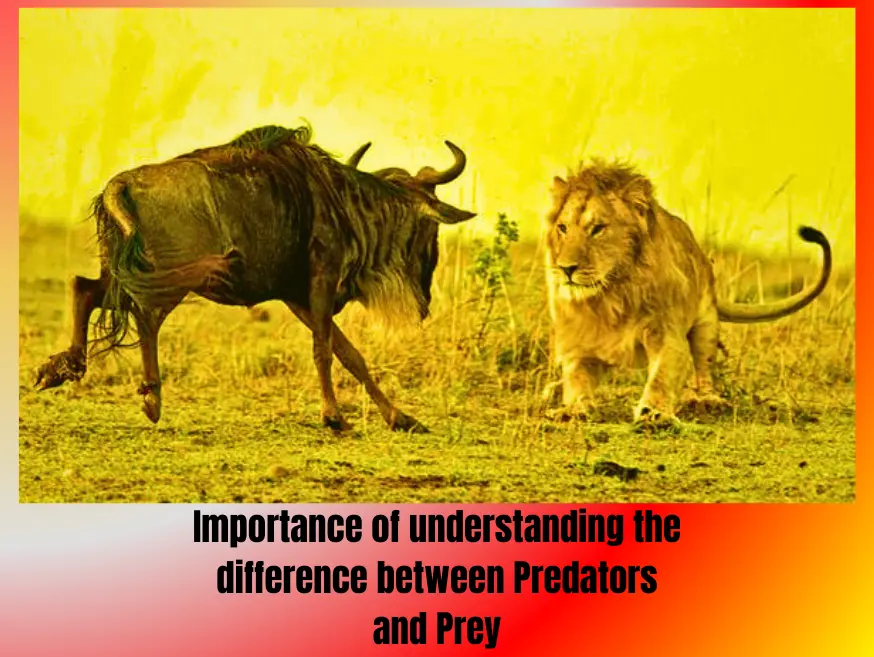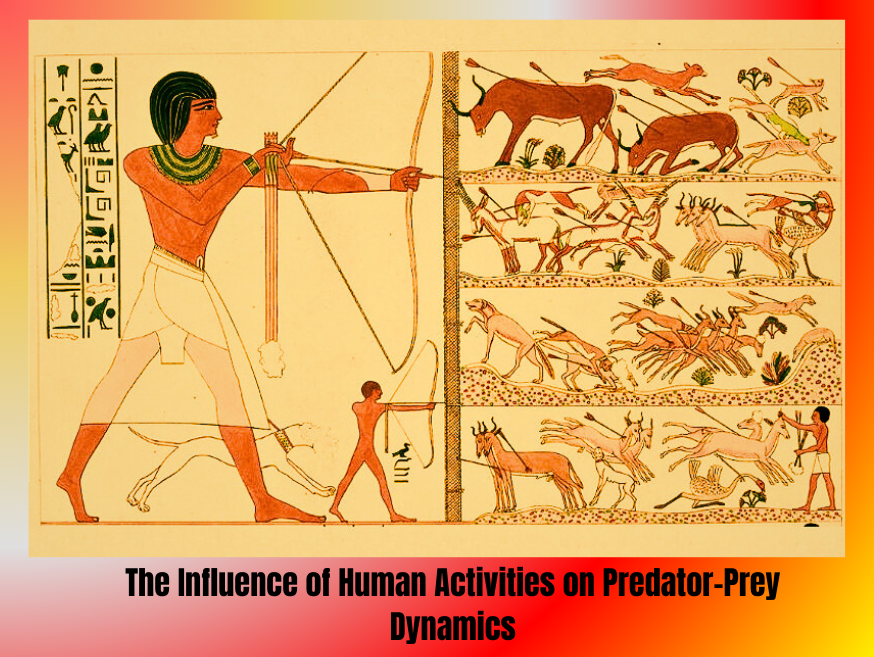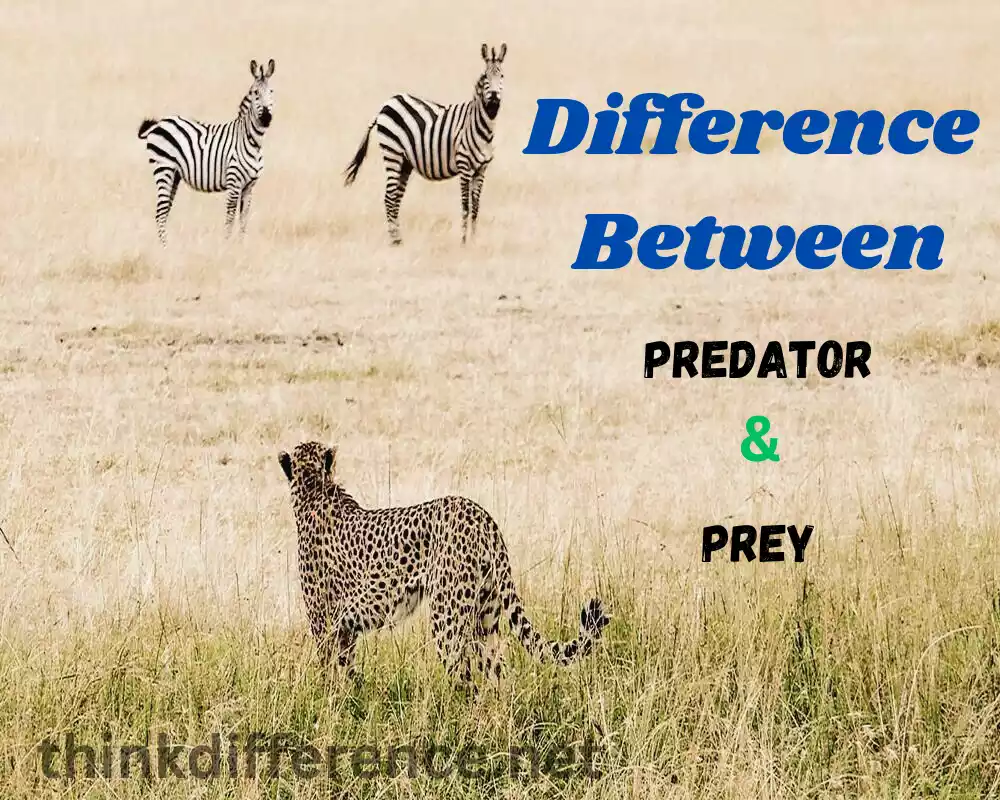Predator and Prey interactions refer to interactions among animals where one species (the hunter) kills and consumes another (the prey) as food sources, having an enormously significant impact on ecosystem structure and dynamics. This relationship plays a pivotal role in maintaining ecological equilibrium.
A short definition of Predator and Prey
Predators are organisms which hunt, kill and consume other organisms known as prey for sustenance. Predators can either be carnivorous, omnivorous or both. Their survival relies on other living creatures for sustenance. They have evolved specific physical adaptations, sharp teeth and claws, enhanced senses, and speed, to effectively capture and subdue their prey.
Predators play a crucial role in ecosystems by controlling population sizes, maintaining ecological balance, and influencing species diversity. They are an integral part of food chains and contribute to the overall health and functioning of natural environments.

Prey refers to an organism that is hunted, killed, and consumed by another organism known as a predator. Prey animals are the target of predators and serve as a source of food for them. There is an array of predators out there. They include herbivores and omnivores alike. Prey species have evolved various adaptations to increase their chances of survival, camouflage, defensive structures (spines, shells), and heightened senses.
They also exhibit anti-predator behaviors like vigilance, alarm calls, and flocking to protect themselves from being caught by predators. Prey populations are crucial in maintaining ecological balance and serve as a vital component of food webs and ecosystems.
Importance of understanding the difference between Predators and Prey

Learning the difference between prey and predators is important for various reasons:
- Ecological Balance: Ecosystems consist of predators and prey that interact, playing an essential part in maintaining environmental balance. Predators help control prey populations, preventing them from overgrazing or overpopulating, which can have detrimental effects on habitats and other species. Understanding these dynamics allows us to appreciate the delicate balance of nature and its intricate web of relationships.
- Conservation and Management: Understanding predator-prey dynamics will enable you to protect species and manage ecosystems effectively. Conservationists can craft effective strategies by studying interactions between predators & prey; this enables them to protect vulnerable species, restore their habitats and maintain diverse ecosystems.
- Human Food Systems: Understanding the difference between predators and prey is also relevant to human food systems. By studying the behaviors, habitats, and interactions of prey species, we can gain insights into sustainable harvesting practices, responsible fishing, and effective wildlife management for both conservation and human sustenance purposes.
- Coexistence and Conflict: In some cases, human activities may bring predators and prey into contact with human settlements or agricultural areas, leading to conflicts or potential dangers. Understanding predators’ and preys’ needs and behaviors is crucial in order to take measures that reduce conflict, foster coexistence, and ensure both human and wildlife safety.
- Education and Awareness: Knowledge about predators and prey fosters a deeper appreciation and understanding of the natural world. It allows us to recognize the intricate and interconnected relationships between species and appreciate the diverse strategies and adaptations that have evolved through millions of years. This understanding can inspire conservation efforts, promote environmental stewardship, and encourage sustainable practices.
Understanding Predator and Prey relationships is critical for sustainable ecosystems, protecting biodiversity and encouraging coexistence between humans, animals, and the environment. Such knowledge allows us to make smarter decisions regarding conservation efforts, resource use management practices and responsible resource utilization.
Characteristics of Predators
Predators possess several distinctive characteristics that enable them to hunt, capture, and consume their prey effectively.
These characteristics include:
1. Carnivorous Diet: Predators primarily feed on other animals as their main source of nutrition. Their digestive systems are adapted to process and extract nutrients from the flesh and tissues of their prey.
2. Physical Adaptations: Predators have evolved specific physical traits that aid in hunting and capturing prey. These adaptations can vary depending on the predator’s habitat and prey species, but some common physical traits include:
- Sharp Teeth and Claws: Many predators possess sharp teeth and claws that are specialized for seizing and tearing apart their prey. Examples include the sharp fangs of big cats, the hooked beaks of raptors, or the formidable jaws of crocodiles.
- Enhanced Senses: Predators often have heightened senses, such as acute vision, excellent hearing, and a keen sense of smell. These senses help them detect and locate their prey from a distance, even in challenging environments.
- Speed and Agility: Many predators are exceptionally fast and agile, allowing them to chase down and capture swift prey. They possess powerful muscles and streamlined bodies that enable them to sprint, leap, and maneuver with precision.
3. Hunting Strategies: Predators employ various hunting strategies to capture their prey effectively. These strategies can include:
- Ambush Predators: Some predators rely on stealth and camouflage to surprise their prey. They patiently wait in concealed positions and swiftly attack when an opportunity arises. Examples include spiders lying in wait for insects or crocodiles lurking beneath the water’s surface.
- Pursuit Predators: These predators have adaptations for chasing down and overtaking their prey through speed and endurance. They employ relentless pursuit to catch their quarry. Cheetahs are a classic example of pursuit predators.
- Cooperative Hunting: Certain predators, such as wolves and lions, engage in cooperative hunting. They work together in coordinated groups, employing strategies like surrounding, herding, or isolating prey to improve their chances of success.
4. Dietary Specializations: Predators can exhibit specific dietary specializations, targeting particular prey species or specific sizes of prey. Some predators are highly specialized, focusing on a narrow range of prey items, while others have a broader diet.
5. Energy Efficiency: Predators have evolved efficient energy systems to sustain themselves between successful hunts. They often have higher metabolic rates compared to prey species, allowing them to convert their prey’s energy into their own energy needs.
Understanding these characteristics helps us appreciate the unique adaptations and strategies that predators have evolved to survive and thrive in their respective ecosystems. It also highlights their crucial role in maintaining ecological balance and shaping the dynamics of natural communities.
Characteristics of Prey
Prey species possess various characteristics that help them evade predators and increase their chances of survival.
These characteristics include:
1. Herbivorous or Omnivorous Diet: Prey species primarily feed on plants (herbivores) or a combination of plants and other organisms (omnivores). Their digestive systems are adapted to process vegetation or a diverse range of food sources.
2. Defensive Structures and Adaptations: Prey species often possess physical structures or adaptations that provide protection against predators. Some common defensive characteristics include:
- Camouflage: Many prey species have evolved coloration patterns or body shapes that blend with their surroundings, making it harder for predators to detect them. Examples include the cryptic coloring of certain insects or the camouflage patterns of some ground-dwelling birds.
- Defensive Armor: Some prey species have evolved hard shells, spines, or thick hides that act as physical barriers against predators. Armadillos and tortoises are notable examples.
- Warning Signals: Certain prey species have developed warning signals to alert other individuals of imminent danger. This can include vocalizations, specific postures, or displays of bright colors to deter predators or attract attention from potential predators of the predator itself (e.g., mobbing behavior).
3. Speed, Agility, and Evasive Behavior: Prey species often possess adaptations that allow them to escape from predators through quick movements and evasive behaviors. Some characteristics include:
- Speed and Endurance: Many prey species are swift runners or have adaptations for rapid bursts of speed, enabling them to outrun pursuing predators. Examples include antelopes, rabbits, and gazelles.
- Agility and Maneuverability: Prey species may possess flexible bodies or specialized locomotor abilities that allow them to navigate through complex terrain or change direction rapidly, evading predator attacks. Tree-dwelling primates and flying insects exhibit exceptional agility.
- Evasive Behaviors: Prey species may exhibit specific behaviors that confuse or distract predators, such as zigzag running patterns, sudden changes in direction, or jumping into water bodies to escape. These behaviors increase the chances of survival by making it difficult for predators to catch them.
4. Vigilance and Group Behavior: Prey species often demonstrate heightened vigilance and engage in group behavior as a defense mechanism against predators. These characteristics include:
- Increased Awareness: Prey species have heightened senses, such as acute vision, hearing, and smell, allowing them to detect potential threats quickly. They remain alert to changes in their environment and potential signs of predator presence.
- Alarm Calls and Signals: Many prey species emit vocalizations or other signals to alert nearby individuals of the presence of a predator. This warning system helps individuals within the group take appropriate defensive actions or seek safety.
- Safety in Numbers: Some prey species gather in groups or herds to increase their chances of detecting predators and deterring attacks. The collective presence of multiple individuals makes it more challenging for predators to single out and capture a particular prey.
Understanding these characteristics of prey species helps us comprehend their strategies for survival and the remarkable adaptations they have developed to minimize predation risk. It emphasizes the importance of predator-prey interactions in shaping the behavior and evolution of both predator and prey populations in diverse ecosystems.
Comparison table of Predators and Prey
Here’s a comparison table highlighting some key differences between predators and prey:
| Aspect | Predators | Prey |
|---|---|---|
| Diet | Feed on other organisms (carnivorous or omnivorous) | Feed on plants (herbivorous) or other organisms |
| Physical adaptations | Sharp teeth, claws, enhanced senses, speed, agility | Camouflage, defensive structures, speed, agility |
| Hunting strategies | Ambush, pursuit, cooperative hunting | Vigilance, alarm calls, flocking, evasive maneuvers |
| Role in ecosystems | Regulate prey populations, maintain balance | Provide food for predators, shape ecological dynamics |
| Coevolution | Adaptations in response to prey behaviors | Adaptations in response to predation pressure |
| Conservation focus | Protection of predator populations, keystone species | Protection of vulnerable prey, ecological balance |
| Human impacts | Habitat loss, overexploitation, climate change | Habitat loss, overexploitation, disturbance |
| Implications for conservation | Ensuring predator conservation, managing prey populations | Protecting prey species, preserving balance in ecosystems |
Role of Predators and Prey in Ecosystems
Predators and prey play vital roles in ecosystems, contributing to the overall functioning, stability, and biodiversity of natural environments. Their interactions have several significant impacts:
- Ecological Balance: Predators help maintain ecological balance by controlling the population sizes of prey species. By feeding on and keeping prey populations in check, predators prevent overgrazing or overpopulation, ensuring the health and sustainability of habitats and resources. This regulation of prey populations contributes to a balanced distribution of energy and resources within ecosystems.
- Trophic Levels: Predators occupy higher trophic levels in food chains or food webs, while prey species typically occupy lower trophic levels. These trophic relationships create a flow of energy and nutrients through the ecosystem, with predators relying on the energy stored in the bodies of prey species. Predators effectively transfer energy from lower trophic levels to higher trophic levels, supporting the diversity of species in an ecosystem.
- Control of Species Diversity: Predators play a crucial role in shaping species diversity by influencing prey populations. By selectively targeting certain prey species or individuals, predators can impact the distribution and abundance of prey species within an ecosystem. This selective pressure contributes to maintaining a diverse range of species, as it favors the survival and proliferation of certain prey species that possess effective defensive strategies or adaptations.
- Behavioral and Morphological Adaptations: As prey species have come under pressure from predators, they have evolved various behavioral and morphological adaptations in response. These adaptations include camouflage, warning signals, defensive structures, and evasive behaviors. The presence of predators exerts selective pressure on prey species, driving the evolution of these adaptations and enhancing their survival strategies. In turn, the pursuit and capture of prey have shaped the hunting strategies, physical attributes, and sensory capabilities of predators.
- Trophic Cascades: The presence or absence of predators can have cascading effects on multiple trophic levels within an ecosystem. Removing top predators may result in an increase in prey species and, consequently, decrease their food source, which will have negative repercussions for lower trophic levels and their subsystems. Such cascading of trophic levels has wide-reaching ramifications on ecosystem dynamics.
- Nutrient Cycling: Predators’ consumption of prey contributes significantly to the cycling of nutrients within ecosystems. When their prey are decomposed or excreted by predators, its nutrients enter the environment for recycling through decomposition or excretion processes. This recycling of nutrients helps maintain nutrient availability and balance within ecosystems, benefiting primary producers and supporting the overall productivity of the ecosystem.
By understanding how predators function within ecosystems, it’s possible to conserve resources, manage them sustainably and protect biodiversity. Their interactions and dynamics are integral to the functioning and resilience of ecosystems, emphasizing the need for their protection and conservation.
The Influence of Human Activities on Predator-Prey Dynamics

Human activities can have significant impacts on predator-prey dynamics, often leading to disruptions and imbalances within ecosystems. Some of the ways human activities influence predator-prey dynamics are:
- Habitat Loss and Fragmentation: Human activity often results in habitat degradation or fragmentation, including urbanization, deforestation and land conversion for agriculture. This can directly impact both predators and prey by reducing their available habitat and limiting their access to resources. Disrupted habitats can disrupt predator-prey interactions, affecting feeding opportunities, hunting success, and prey availability.
- Overexploitation of Prey: Humans can exert excessive pressure on prey species through activities like overfishing, excessive hunting, or unsustainable harvesting practices. Overexploitation of prey by predators may reduce their availability for consumption and upend the delicate balance between predators and their prey that ensures reproductive success and survival.
- Introduction of Non-Native Species: Human introduction of non-native species, intentionally or unintentionally, can disrupt predator-prey dynamics. Invasive predators can threaten native prey species that have not evolved defenses against them, leading to declines in prey populations. Conversely, the introduction of prey species without natural predators can disrupt local ecosystems by outcompeting native species or overgrazing vegetation.
- Climate Change: Climate change caused by humans has the power to drastically change predator-prey dynamics. Temperature, precipitation patterns and habitat considerations all play a part in how predators find prey. Alterations in prey availability, such as changes in migratory patterns or shifts in prey phenology, can disrupt the foraging behaviors and reproductive success of predators.
- Hunting and Wildlife Management: Human hunting practices and wildlife management strategies can impact predator-prey dynamics. Overhunting predators could result in an increased prey population and create ecological imbalances or overgrazing issues. Conversely, human efforts to control prey populations, such as culling or selective hunting, can affect predator populations by reducing their food sources.
- Pollution and Contamination: Human pollution, including chemical pollutants, oil spills, and pesticides, can have indirect effects on predator-prey dynamics. Contaminated prey can result in reduced prey quality and reproductive success for predators. Furthermore, pollutants can accumulate in predator species, affecting their health, reproduction, and behavior, ultimately impacting their ability to hunt or survive.
It is important to recognize and mitigate these human influences on predator-prey dynamics to maintain the health and functioning of ecosystems. Conservation efforts such as sustainable resource management, habitat rehabilitation and responsible wildlife practice can help lessen human activities’ harmful impact on predator-prey interactions and ensure eco-system stability.
Behavioral Strategies of Predators and Prey
Predators and prey have developed various behavioral strategies to enhance their chances of survival and reproduction. These strategies are shaped by the selective pressure exerted by predator-prey interactions.
Here are some common behavioral strategies observed in predators and prey:
Behavioral Strategies of Predators:
- Ambush: Predators that employ ambush strategies remain still and concealed, waiting for an opportune moment to surprise their prey. This strategy takes advantage of stealth and camouflage to get close to unsuspecting prey before launching a sudden attack.
- Pursuit: Pursuit predators rely on speed and agility to chase down their prey. They have adaptations such as long limbs, streamlined bodies, and high endurance to run or swim after their prey over long distances.
- Cooperative Hunting: Some predators exhibit cooperative hunting behavior, working together in coordinated groups to increase their hunting success. This strategy involves dividing roles, surrounding prey, or using coordinated movements to isolate and capture the targeted prey.
- Stalking: Stalking predators carefully and silently approach their prey, minimizing the chances of detection. They move slowly and cautiously, making calculated movements to get within striking distance before launching an attack.
Behavioral Strategies of Prey:
- Vigilance: Prey species are often highly vigilant, constantly scanning their surroundings for potential predators. They rely on keen senses, such as sharp eyesight or acute hearing, to detect any signs of danger and react accordingly.
- Alarm Calls and Signals: Many prey species have developed specific vocalizations or visual signals to alert others of the presence of a predator. These alarm signals communicate the imminent threat, enabling nearby individuals to take evasive action or be on high alert.
- Flocking or Herding: Prey species often gather in groups or herds, which provides several benefits. Grouping together enhances the ability to detect predators, dilutes the risk for individuals, and allows for coordinated defense or evasion strategies. The “safety in numbers” concept helps reduce an individual’s risk of being targeted by predators.
- Evasive Maneuvers: When prey species detect a predator, they employ evasive maneuvers to avoid capture. These maneuvers can include sudden changes in direction, zigzag running patterns, leaping, or taking advantage of complex terrain to confuse and elude their pursuers.
- Defensive Adaptations: Some prey species possess physical adaptations for defense, such as spines, horns, or armor, which can deter or harm predators. They may use their defensive structures in confrontations with predators or rely on defensive behaviors like playing dead, bluffing, or using distraction displays to escape predation.
Behavior strategies vary significantly across species and environments. Predators and prey continuously adapt their behaviors in response to each other’s strategies, resulting in a dynamic interplay that shapes the outcomes of predator-prey interactions.
Implications for Conservation on Predator and Prey
Understanding predator and anti-predator behaviour is vital for proper conservation efforts. Here are some key implications of such behaviour for species protection:
- Predator Conservation: Recognizing the importance of predators in maintaining ecological balance and biodiversity, conservation efforts should prioritize the protection and conservation of predator species. By safeguarding predator populations and their habitats, we can ensure the integrity of predator-prey interactions and promote healthy ecosystems.
- Prey Species Conservation: Prey species, particularly those targeted by conservation efforts due to their vulnerability or ecological importance, should be protected. This involves conserving their habitats, addressing threats such as habitat loss or fragmentation, and managing human activities that impact prey populations. By maintaining robust prey populations, we support predator populations and the overall balance of ecosystems.
- Keystone Predator Conservation: Keystone predators, which have disproportionately strong effects on ecosystem structure and diversity, should receive special attention in conservation efforts. The loss or decline of keystone predators can trigger cascading effects throughout the food web and lead to ecological imbalances. Protecting and restoring keystone predator populations can help maintain biodiversity and ecosystem health.
- Habitat Conservation: Effective conservation strategies should focus on protecting and restoring habitats that support both predators and prey. This involves preserving diverse ecosystems, addressing habitat fragmentation, and ensuring connectivity between habitats. Protecting key habitat features, such as nesting sites, hunting grounds, and migration routes, is vital for maintaining predator-prey dynamics.
- Mitigating Human Impacts: Human activities that disrupt predator-prey interactions should be mitigated to conserve biodiversity. This includes reducing habitat destruction, mitigating the introduction of invasive species, implementing sustainable fishing and hunting practices, and minimizing pollution and contamination that can harm both predators and prey.
- Ecosystem-Based Management: Conservation efforts should adopt an ecosystem-based approach that considers the intricate relationships between predators, prey, and their habitats. By recognizing the interdependence of species within ecosystems, management strategies can be developed to preserve and restore natural processes and maintain the balance of predator-prey dynamics.
- Monitoring and Research: Continuous monitoring and research on predator-prey interactions are essential for conservation. This includes studying population dynamics, behavior, habitat requirements, and the impacts of human activities on predator and prey species. Such knowledge can inform adaptive management approaches and improve conservation strategies.
By integrating these implications into conservation practices, we can enhance the resilience and functionality of ecosystems, preserve biodiversity, and ensure the long-term survival of both predators and prey species.
Conclusion
Understanding the differences among predators, prey and ecosystem dynamics is crucial in understanding predator-prey dynamics. Predators are organisms that seek out, kill and consume other organisms – thus becoming predators themselves! The characteristics, behaviors, and adaptations of predators and prey shape their interactions and influence the structure, balance, and biodiversity of ecosystems.
Knowledge of predator-prey relationships and their conservation implications are integral to maintaining ecosystem integrity and function. By understanding their impact and impact on conservation we can promote biodiversity, ensure long-term ecosystem health and contribute to sustainability by maintaining a harmonious balance among predators, prey, and their natural environments.



